20 Minutes With Lake Speed, Jr.
Thomas T. Astrene, Publisher | TLT 20 Minutes June 2009
With a name built for racing, this NASCAR specialist relies on STLE for help in designing specialty lubricants.
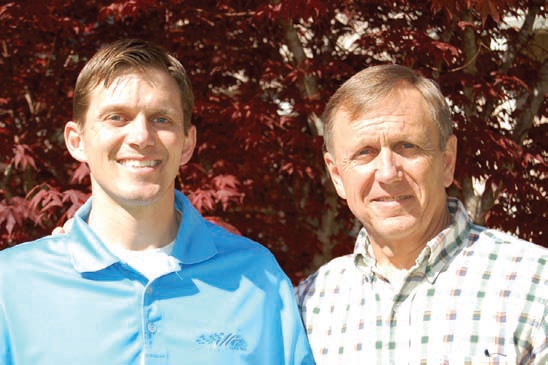 Lake Speed, Jr. (left) with Lake Speed, Sr.
Lake Speed, Jr. (left) with Lake Speed, Sr.
The Speed family has been involved in professional motorsports for more than 40 years.
TLT: WHAT WAS THE CAREER PATH THAT TOOK YOU TO YOUR CURRENT POSITION?
Speed: I started racing go-karts when I was eight years old, but by the time I was a teenager I realized a driving career was not for me.
My father raced in NASCAR from 1980 until 1998. For many of those years, Dad operated our own independent race team in the Charlotte area, so I spent several summers working on Dad’s team. I started by sweeping the floors and taking out the trash. By the time I went to college, I was traveling with the team.
At the time, my mom lived in Nashville, Tenn., and worked for an advertising agency, so I decided to try my hand advertising instead of racing. I attended the University of Tennessee in Knoxville, and in May 1996 I graduated with a bachelor’s degree in communications. After graduation, I moved to Charlotte, N.C., and I went to work for a local advertising agency.
I learned really quick that working on race cars was a lot more fun than designing ads for banks, so I went to work for Melling Racing. We fielded the No. 9 NASCAR team that Bill Elliott made famous back in the late-1980s. Melling Racing was also one of the original Dodge teams when Dodge got back into NASCAR in 2001. After working for Melling Racing, I joined Joe Gibbs Racing in 2004.
TLT: HOW DID YOU FIRST GET INVOLVED WITH LUBRICANTS?
Speed: While I was at Melling Racing, we purchased a chassis dynamometer, and we began an engineering co-op program with the University of Tennessee. One of the reasons for purchasing the chassis dyno was to test engine and gear oils for potential power gains.
One of my jobs was to secure products for testing on the chassis dyno after we installed the unit. When it came to proper oil testing, we did not have any clue what we were doing. We purchased many different brands of low-viscosity oils, and we purchased different aftermarket additives. Our basic premise was that lighter viscosity must be better, and if one bottle of additive is good, then two must be better.
In the end, the “blends” we came up with could make a few more horsepower than an API SJ/GF-2 synthetic 5W-30. Our blend also would damage the motor after about five laps, so we only used it for qualifying. We also violated many other principles of proper lubrication for the sake of horsepower during qualifying. We would bypass the oil cooler and oil filter completely, and we would run about a 100-micron air filter. After subjecting the engine to all of this, we would complain that our engines did not make good horsepower after the race was over. We were our own worst enemy, but we simply did not know any better.
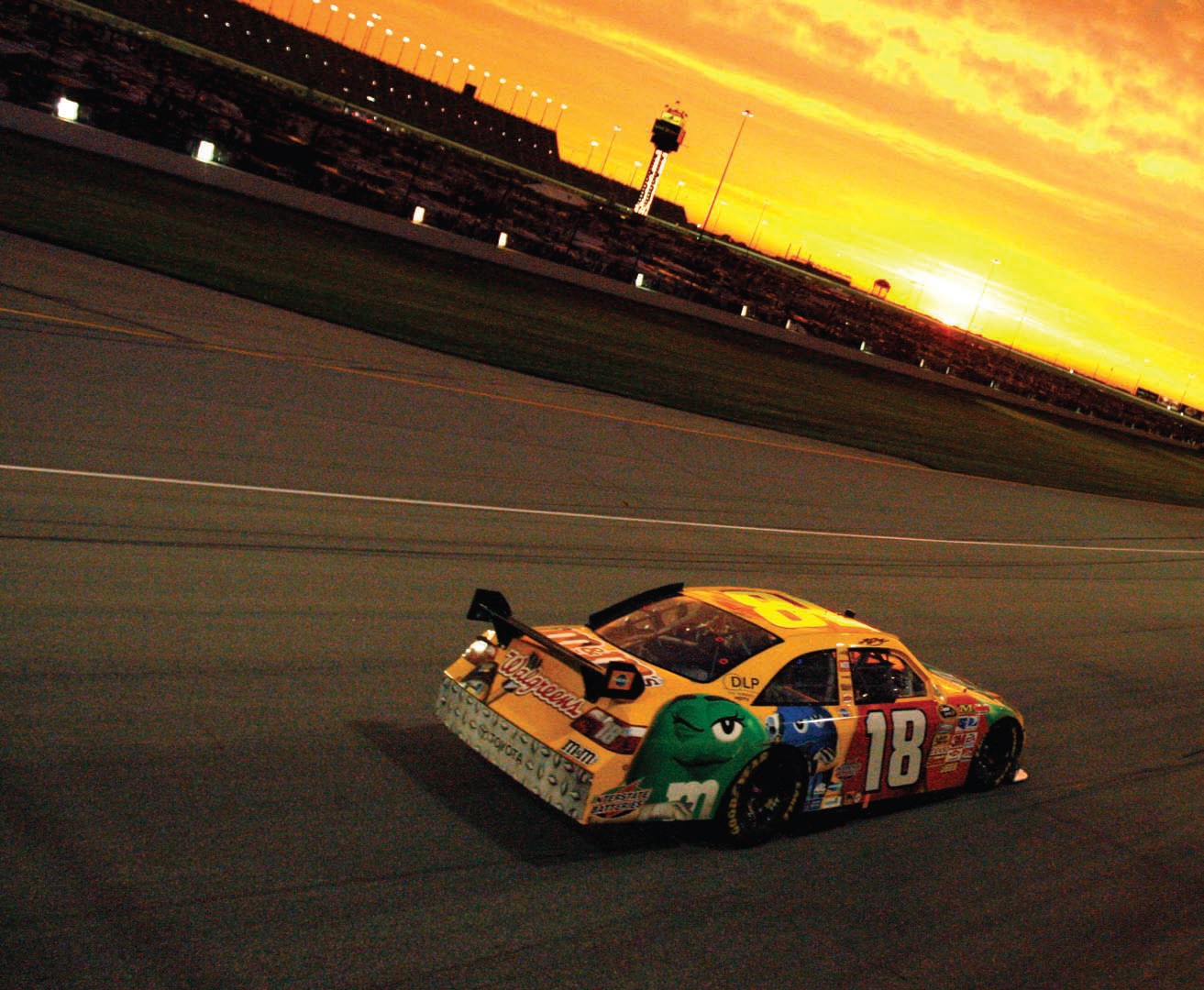 TLT: NASCAR HAS A RICH HISTORY OF OIL COMPANIES AS TEAM SPONSORS. WHAT INVOLVEMENT HAVE YOU HAD WITH OIL COMPANIES AS TEAM SPONSORS IN NASCAR?
TLT: NASCAR HAS A RICH HISTORY OF OIL COMPANIES AS TEAM SPONSORS. WHAT INVOLVEMENT HAVE YOU HAD WITH OIL COMPANIES AS TEAM SPONSORS IN NASCAR?
Speed: Back in 1985 Valvoline was an associate sponsor on the car Dad drove that year. In 1988 Dad was sponsored by Wynn’s Friction Proofing, and we won the NASCAR race at Darlington Raceway. In 1991, Dad drove the Phillips 66 car for several races, and at Melling Racing we had sponsorship from Motorcraft brand oil (produced by ConocoPhillips).
I have a picture from a photo shoot of my Dad posing with a can of Valvoline 20W-50 Racing Oil sitting on my desk today, so maybe a career in lubrication was foreshadowed by my Dad’s sponsors? Also, Melling Racing’s parent company is the largest producer of aftermarket automotive oil pumps in the U.S., so it has always been around me.
TLT: LAKE SPEED IS A GREAT NAME FOR RACING. HOW DID YOU GET YOUR UNUSUAL NAME?
Speed: My father was named after my grandfather’s two best friends—Bob Lake and Paul Chambers, so I am Lake Chambers Speed, Jr. Oddly enough, the current NASCAR driver Scott Speed is not my brother or cousin. All of the Speeds in the U.S. trace back to England in the 1600s, so I guess we are family somewhere down the line.
TLT: WHAT KIND OF TEAM IS JOE GIBBS RACING? HOW MANY PEOPLE AND CARS?
Speed: Joe Gibbs Racing fields three cars in the NASCAR Sprint Cup series for drivers Kyle Busch, Denny Hamlin and Joey Logano. Dale Jarrett, Bobby Labonte and Tony Stewart also drove for Joe Gibbs Racing. Both Bobby Labonte (2000) and Tony Stewart (2002 & 2005) won NASCAR championships at Joe Gibbs Racing.
We also field two cars in the NASCAR Nationwide Series, and JGR won the owners’ championship in the NASCAR Nationwide Series last year. In 2008, we launched JGR MX, an AMA Motorcross and Supercross team.
All in all, over 400 people make up Joe Gibbs Racing. We have three shops in Huntersville, N.C., that field the NASCAR Sprint Cup, NASCAR Nationwide and AMA Motorcross teams. We also build our own engines and chassis in-house.
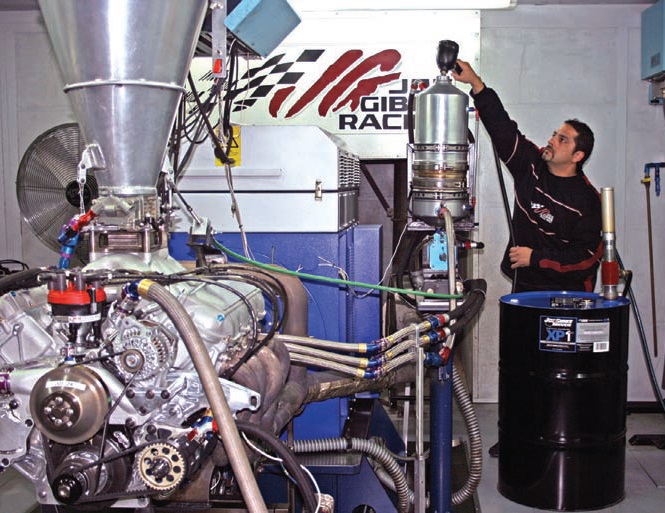 Joe Gibbs Racing uses dynamometers to test everything from camshafts to oil. Here an engine shop employee fills the 22-quart dry sump system with the synthetic 5W-20 oil that JGR uses in their 870+ HP engines.
TLT: HOW DO NASCAR RACE ENGINES DIFFER FROM PASSENGER CAR ENGINES? WHAT ARE THE SPECIAL DEMANDS MADE ON THESE ENGINES?
Joe Gibbs Racing uses dynamometers to test everything from camshafts to oil. Here an engine shop employee fills the 22-quart dry sump system with the synthetic 5W-20 oil that JGR uses in their 870+ HP engines.
TLT: HOW DO NASCAR RACE ENGINES DIFFER FROM PASSENGER CAR ENGINES? WHAT ARE THE SPECIAL DEMANDS MADE ON THESE ENGINES?
Speed: Even though it is called Stock Car racing, we don’t use production engines. We don’t even get to use roller-follower camshafts or computerized ignition and fuel control.
NASCAR rules require us to run flat-tappet camshafts in our NASCAR Sprint Cup series engines. These engines are maximum 358 C.I. V-8s. We must run a distributor. We must run a single 4-barrel carburetor. We must have pushrods, but we turn these engines over 9,000 rpm for over 500 miles. Our current unrestricted engine specification makes more than 860 hp on unleaded gasoline.
Obviously, the valve train loads are very high due to the spring pressures required to control the mass and inertia of a 9,000-rpm push-rod valve train. Fortunately, we don’t have emission control equipment to worry about, so we can be creative with lubricants for our engines.
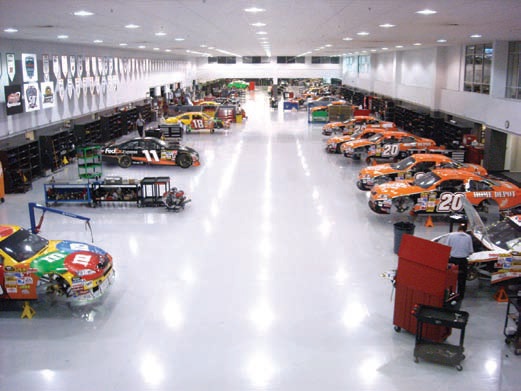 The main car prep area at Joe Gibbs Racing looks as long as a football playing field, and it actually is. Paying tribute to Coach Gibbs’ success in the NFL, JGR’s shop has a few football-inspired features.
TLT: WHAT ARE THE LUBRICANT REQUIREMENTS FOR NASCAR RACE CAR ENGINES? WHAT ARE THE BIGGEST ISSUES?
The main car prep area at Joe Gibbs Racing looks as long as a football playing field, and it actually is. Paying tribute to Coach Gibbs’ success in the NFL, JGR’s shop has a few football-inspired features.
TLT: WHAT ARE THE LUBRICANT REQUIREMENTS FOR NASCAR RACE CAR ENGINES? WHAT ARE THE BIGGEST ISSUES?
Speed: Breaking in a flat-tappet camshaft and keeping it alive at 9,000 rpm is our biggest lubricant-related issue. In recent years we’ve begun to use camshafts ground from steel billets instead of cast iron. With the steel billet camshafts come diamond-like carbon (DLC) coated tool steel flat tappet lifters. We’ve found that a high ZDDP treat rate oil is critical for breaking-in a new billet camshaft and DLC coated lifter.
After the camshaft and lifter are broken in, we switch to full synthetic oils for the actual races. We spray oil directly on our pistons, camshaft and valve springs to keep these critical components cool, so PAO base oils are employed due to the high bulk oil temperatures. We typically see oil at temperatures well over 250 F, so the oil must provide boundary layer protection for a highly loaded valve train and handle high sustained operating temperatures.
TLT: WHAT IS YOUR PROCESS FOR DEVELOPING LUBRICANTS FOR NASCAR RACE CARS? HOW DO YOU TEST THEM?
Speed: Joe Gibbs Racing has two AVL engine dynos as well as a Spintron unit. The Spintron is used to test valve train dynamics, and we use it to validate an oil’s ability to create a sufficient boundary layer. Our engine dynos can run full race simulations, so we also use race simulations to test and validate oils.
Our typical oil test works as follows:
1.
Break in a new engine using a high ZDDP, Group I basestock oil.
2.
Switch to our baseline Group IV/Group V blend race oil.
3.
Verify the power of the engine (power runs at 200 F, 225 F and 250 F oil in temps).
4.
Drain baseline oil and flush the system with a Group I basestock oil for 20 minutes.
5.
Switch to the test oil and run the engine for 20 minutes.
6.
Verify the power of the engine with the test oil (power runs at 200 F, 225 F and 250 F oil in temps).
7.
Perform a 600-mile durability run using the test oil.
8.
Reverify the power of the engine with the test oil (power runs at 200 F, 225 F and 250 F oil in temps).
9.
Disassemble the engine and inspect the parts.
10.
Send off used oil for analysis.
Due to the limited power output of the restrictor plate engines mandated by NASCAR for use only at Daytona and Talladega Superspeedways, most of our oil development centers around trying to squeeze two to three more horsepower from a 490-hp engine. After a race at Daytona or Talladega, we will test a new formula on one of the unused, back-up engines.
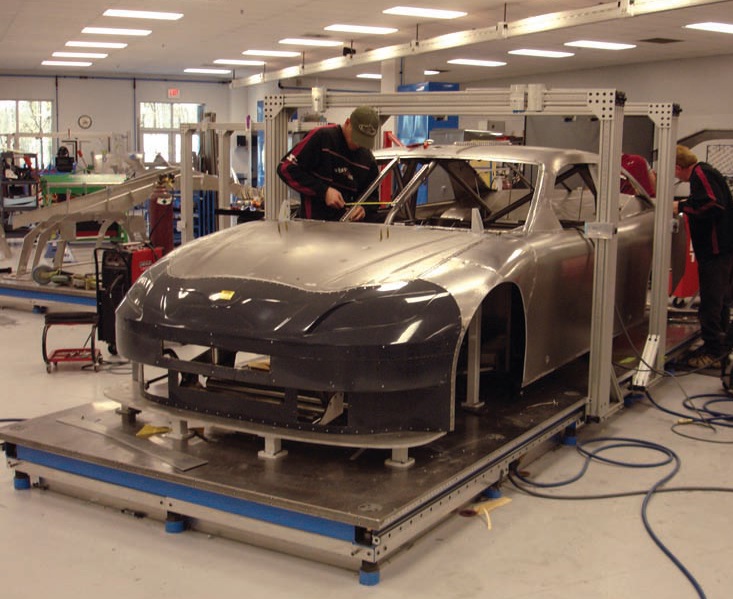 Joe Gibbs Racing fabricates their NASCAR vehicles in-house. From chassis and body fabrication to complete engine building, the JGR racing shop occupies more than 100,000 square feet.
TLT: WHO DOES JOE GIBBS RACING WORK WITH TO DEVELOP THESE OILS?
Joe Gibbs Racing fabricates their NASCAR vehicles in-house. From chassis and body fabrication to complete engine building, the JGR racing shop occupies more than 100,000 square feet.
TLT: WHO DOES JOE GIBBS RACING WORK WITH TO DEVELOP THESE OILS?
Speed: Over the years, we’ve worked with different oil companies that sponsored our cars to develop oils for Joe Gibbs Racing. Today, we work with two different specialty chemical companies to supply Joe Gibbs Racing with finished products.
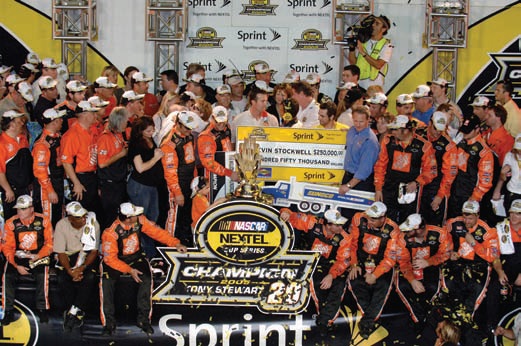 Since starting development of specialized lubricants, Joe Gibbs Racing has won three NASCAR Sprint Cup championships and the 2008 NASCAR Nationwide Series championship.
TLT: WHY GET INVOLVED WITH STLE?
Since starting development of specialized lubricants, Joe Gibbs Racing has won three NASCAR Sprint Cup championships and the 2008 NASCAR Nationwide Series championship.
TLT: WHY GET INVOLVED WITH STLE?
Speed: Racing is competition, and our job is to win. By getting involved with STLE, we hope to learn more about lubrication. If we are on the forefront of lubrication technology, maybe we can translate new ideas and technologies into a competitive advantage on the racetrack. Simply put, we are here to learn from the experts.
(All photos courtesy of Joe Gibbs Racing)
You can reach Lake Speed, Jr., at lspeed@joegibbsracing.com.